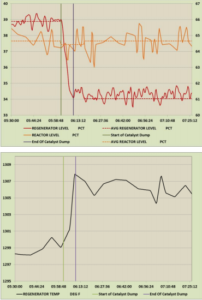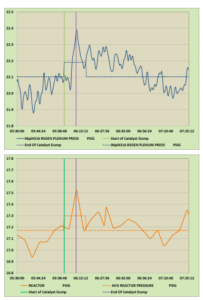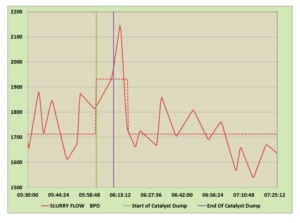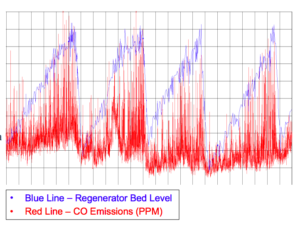This article was adapted from a presentation given at RefComm® Valencia by Kate Hovey of Johnson Matthey.
Catalyst Withdrawals in Refineries
Most FCC units withdraw catalyst manually, once every few days. However, there are some disadvantages of batch withdrawal. Manual withdrawal offers poor control of withdrawal rate due to the manual adjustments of catalyst and carrier air flows. High temperature and poor velocity control results in high erosion rates of valves and piping. This creates a risk of hot catalyst exposure and requires frequent maintenance. Additionally, batch withdrawal can have a significant impact on unit operation and flue gas emissions.
In her presentation, Ms. Hovey provided some examples of the common issues resulting from batch withdrawal, as outlined below:
Example 1: Yield Effect (data from a U.S. Refinery):
- Withdrawal 5% of regenerator bed in 8 minutes.
- 10,500 lbs catalyst (5% of total inventory).
- Withdrawal rate = 3.5% of cat circulation rate.
- 7 degrees F rise seen in regenerator temperature.
- Clear spike in regenerator pressure during withdrawal.
- Pressure spike affects catalyst circulation.
- Duration of upset is roughly twice as long as withdrawal period.
Consequences of Batch Withdrawal EXAMPLE 2 (data from a U.S. Refinery):
- As regenerator bed level increases, CO emissions increase.
- Bed level has a direct effect on coke burn dynamics and flue gas emissions.
Steadier FCC operation leads to higher profitability. Withdrawal causes 1% volume increase in slurry yield. As Ms. Hovey indicated in her examples above, conventional procedures for unloading FCC catalyst in a batch wise manor have the potential to create many operational safety issues. They can also have negative impacts on the FCC regenerator operation. A continuously controlled catalyst withdrawal system overcomes all safety implications associated with the transfer of high temperature, abrasive catalyst by avoiding thermal cycling of the piping and mitigating pipe erosion. In addition, a commercial application in the U.S. has shown significant process improvements by maintaining steady catalyst inventory levels, resulting in a payback of less than a year.
In the complete presentation, which can be viewed here, Johnson Matthey delves deeper into the data behind using a continuous catalyst withdrawal system, which the company says addresses the main drawbacks of existing systems. The presentation also includes data from the commercial application mentioned above.
For the complete presentation, including an overview of Johnson Matthey’s Mark 2 Catalyst Withdrawal System technology, please visit the presentation page.
____________
View our Past Presentations page to view presentations from past RefComm® conferences.
Click here to view information regarding Johnson Matthey’s FCC addition systems.
RefComm® Galveston 2019 now includes resid hydrocracking!












Leave a Reply
You must be logged in to post a comment.